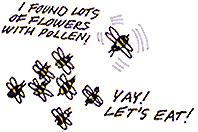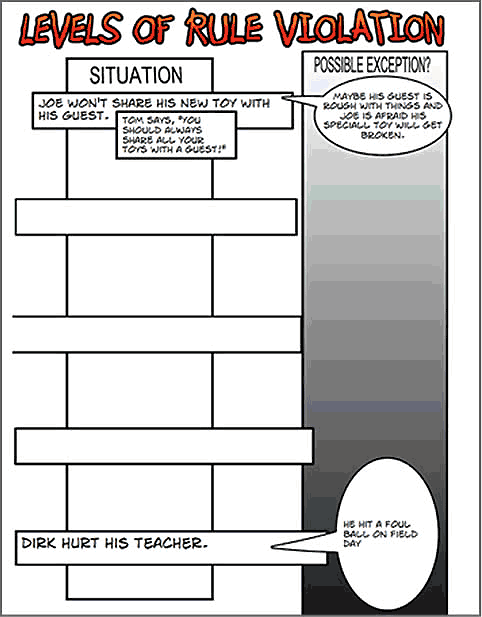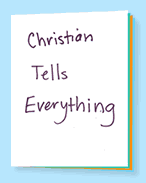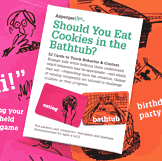Social
Social difficulties are inherent to Asperger’s. It is usually more effective and esteem-building to increase social awareness through explicit teaching rather than repetitively correcting social “mistakes.” Depending on the child’s level of understanding, I also find it helpful to explain how social rules and expectations vary across cultures. This means the child is not “wrong,” but may need to work to improve social skills so that he can access the same opportunities as everyone else. (Click the titles to scroll down the page.)
Expanding Social Knowledge: understanding why social communication is an advantage and differentiating between different types of rules.
Seeing Other Points of View: improving perspective-taking by creating visual stories (such as comics and videos) that illustrate others’ points-of-view
Social Behavior: distinguishing between passive, aggressive, and assertive behaviors
Caring About Social Skills
One of the first hurdles I encounter with some children with ASD is that they do not recognize a need to improve their social skills. Their social skills seem to be of great concern to the adults around them, but the actual reasons for improving these skills often remain elusive. Understanding how these little behaviors fit into the larger scheme of things is limited, so motivation is limited as well.
To illustrate the basic advantage of social communication, I begin with an exploration of animal behavior. I usually start with bees. Put simply, bees “dance” to communicate the location of food to other bees. Usually the child can understand that this is an advantage because it means that each individual bee does not have to cover large expanses of land looking for a bite to eat. Instead, bees spread out and report back when one of them finds something worth “dancing” about.
 The bee example gives specific evidence that communication increases an animal’s chances for survival. Now, what if there were a bee who was off doing his own thing? When he finally looked around and paid attention, the other bees would be elsewhere, eating. He would have missed the message and been hungry as a result. If the child is interested, I would look at other types of animals and the whys and hows of their communication. A biological explanation for communication may make a lot more sense than repeated pleas like, “Don’t you want people to like you?!”
The bee example gives specific evidence that communication increases an animal’s chances for survival. Now, what if there were a bee who was off doing his own thing? When he finally looked around and paid attention, the other bees would be elsewhere, eating. He would have missed the message and been hungry as a result. If the child is interested, I would look at other types of animals and the whys and hows of their communication. A biological explanation for communication may make a lot more sense than repeated pleas like, “Don’t you want people to like you?!”
Different Types of Rules
Most children on the spectrum are quite fond of rules. Unfortunately, no matter how clear-cut many rules seem, there are always exceptions and gray areas, and this is where the child is apt to run into difficulty. Due to the tendency towards black-and-white thinking, it can be difficult for a child with AS to conceptualize behavior on a continuum. After getting into trouble at school, more than one child has asked me, “Am I going to go to jail?” Even those with more sophisticated understanding may be confused or hurt when a friend is perceived as breaking a rule.
To clarify, I recommend creating an illustration with black at one end, white at the other, and shades of gray in between. Next to the continuum, I place a column that says “possible exceptions.” While exceptions might initially cause some confusion, this illustration provides a concrete guide to factors to consider when judging someone else’s behavior and gives the child a broader context to consider. In addition, the illustration provides an alternative to the absolute, black-and-white thinking that rarely corresponds to reality.

Levels of Rules
This illustration (and its explanation) is not a quick fix, but a tool that will have to be re-visited frequently. As more issues emerge, parents can refer to the continuum and record the latest incident. Review of the illustration is essential, as most kids with Asperger’s have difficulty recalling this information and applying it to a new situation. A visual reference helps make these connections stronger.
An excellent discussion of different levels of social rules can be found in Unwritten Rules of Social Behavior by Temple Grandin and Sean Barron. I highly recommend this book to parents, regardless of the child’s age. The personal and factual information provided by these two authors, both with ASD, will help parents to truly see the world through their child’s eyes. This book often gives parents the insight and knowledge base they need to help their child in an informed and intuitive manner.
 Okay, so you’re working on teaching your child “the rules” while gradually increasing information on the complexity of these rules in the real world. While you are working on these bigger lessons, there is a steady stream of interactions to learn from. This is especially important since most individuals with ASD learn best when going from specifics to broader principles (rather than the other way around as is true for most neurotypicals).
Okay, so you’re working on teaching your child “the rules” while gradually increasing information on the complexity of these rules in the real world. While you are working on these bigger lessons, there is a steady stream of interactions to learn from. This is especially important since most individuals with ASD learn best when going from specifics to broader principles (rather than the other way around as is true for most neurotypicals).
Narratives have long been a focus of psychotherapy, both with children and adults. For kids with ASD, a social narrative can be created to convey information about what people might be doing, thinking, or feeling. The key is to make the story visual. For example: PDF
Two excellent books provide more information:
Social Skills Picture Book for High School and Beyond, Baker, Jed (2006). Future Horizons. Available at: amazon.com
Comic Strip Conversations: Colorful, Illustrated Interactions with Students with Autism and Related Disorders, Gray, C. (1994). Future Horizons, Available at:amazon.com
The following resources provide more opportunities to practice seeing other points of view:
 ComicLife software. Available at: amazon.com
ComicLife software. Available at: amazon.com
 Should You Eat Cookies in the Bathtub? The Behavior/Context Card Game
Should You Eat Cookies in the Bathtub? The Behavior/Context Card Game
This card game engages kids while helping them understand which behaviors may be appropriate — and which may not — depending upon the situation. Games of varying complexity are tailored to challenge children as they progress. Created by AspergerLife founder Sally Bloch, Phd. Ages 4–2. Get more information and a link for purchase at https://cookiesinthebathtub.com
Teaching Passive, Aggressive, Assertive Behaviors
Children often benefit from explicit teaching that identifies behaviors that are passive, aggressive, and assertive. By supplying the words to describe these three types of behaviors, you can begin an ongoing sort of “I Spy” game in which family members observe people interacting (on screen or in real life) and identify behaviors that fit one of the three approaches. The goal is to explore alternatives to passively giving in or physical aggression. Specific practice and modeling of assertive behaviors is helpful.
A free workbook to help adolescents and adults to become more assertive is available through the Australian Centre for Clinical Interventions. This extensive workbook, entitled, “Shy No Longer,” is presented in several modules at: https://www.cci.health.wa.gov.au/Resources/Looking-After-Yourself/Social-Anxiety (Click the down-arrow next to “Workbook--Stepping out of Social Anxiety” to see all the Modules; click each one to view or download the PDF file.)
This website is UNDER CONSTRUCTION! Links are NOT YET ACTIVE; content is NOT UPDATED! You can visit our card game Website https://cookiesinthebathtub.com to read about our card game for Aspergers kids and their parents!
